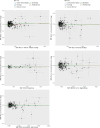Emotional dispositions and intracerebral hemorrhage: a Mendelian Randomization insight
- PMID: 38966007
- PMCID: PMC11222637
- DOI: 10.3389/fgene.2024.1330682
Emotional dispositions and intracerebral hemorrhage: a Mendelian Randomization insight
Abstract
Background: Intracerebral hemorrhage (ICH) is a severe form of stroke with high mortality and limited treatment options. While traditional risk factors like hypertension have been well-studied, the role of emotional states as acute triggers for ICH remains unclear. This study employs Mendelian Randomization (MR) to investigate the causal relationship between emotional traits of worry and anxiety and the incidence of ICH.
Methods: We used a two-sample MR approach, leveraging summary-level data from genome-wide association studies (GWAS) for emotional traits and ICH. The primary analysis was conducted using the Inverse-Variance Weighted (IVW) method, supplemented by multiple sensitivity analyses including Maximum Likelihood and MR PRESSO methods.
Results: Our MR analysis revealed a robust and significant causal relationship between the emotional trait "Worrier/anxious feelings" and ICH, supported by 195 instrumental variables (SNPs). The odds ratio (OR) was 2.98 (95% CI: 1.16, 7.61) with a p-value of 0.0229. Sensitivity analyses corroborated these findings, enhancing the reliability of our results. In contrast, other emotional traits such as "Nervous feelings" and "Sensitivity/hurt feelings" did not show significant associations, reinforcing the specificity of our primary finding.
Conclusion: Our study provides compelling evidence for a causal relationship between the emotional traits of worry and anxiety and the incidence of ICH, offering a new dimension in our understanding of this devastating condition and paving the way for more nuanced risk stratification and preventive strategies.
Keywords: Mendelian randomization; anxiety; emotion; intracerebral hemorrhage; risk factor; single nucleotide polymorphisms; stroke; worry.
Copyright © 2024 Hou, Xu, Buaijier, Yu, Guo, Zhang and Liu.
Conflict of interest statement
The authors declare that the research was conducted in the absence of any commercial or financial relationships that could be construed as a potential conflict of interest.
Figures





References
LinkOut - more resources
Full Text Sources

